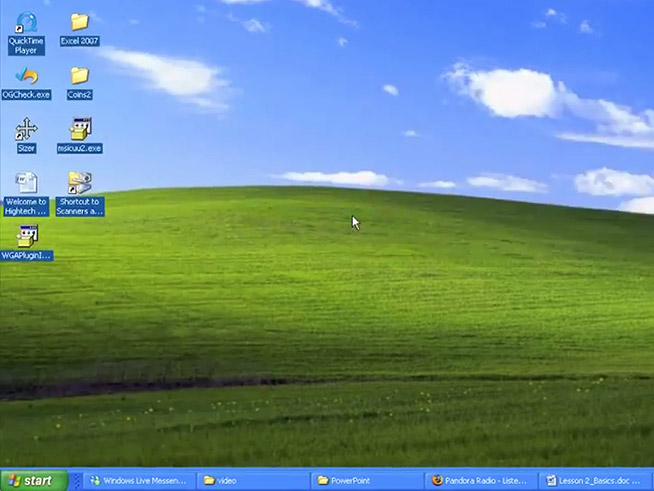In the annals of computing history, few operating systems have left an indelible mark quite like Windows XP. Launched by Microsoft on October 25, 2001, Windows XP was a revolutionary leap forward in the realm of desktop computing, introducing a slew of distinctive features that not only defined an era but continue to influence modern operating systems. This article takes a deep dive into the groundbreaking features that made Windows XP a trailblazer and explores their lasting impact on the world of desktop computing.
1. User-Friendly Interface: The Birth of Luna
At the core of Windows XP’s appeal was its sleek and user-friendly interface, known as Luna. Departing from the visually simplistic design of its predecessors, Luna brought a refreshing aesthetic with its vibrant colors, clear icons, and an intuitive Start menu. The Start button, nestled in the bottom-left corner, became an iconic symbol of Windows XP, providing users with easy access to applications, documents, and system settings. Luna set the standard for modern graphical user interfaces, influencing the design philosophy of subsequent Windows versions.
2. Enhanced Multimedia Experience with Windows Media Player 8
Windows XP elevated the multimedia experience for users with the introduction of Windows Media Player 8. This media player offered enhanced playback features, CD ripping capabilities, and support for a wide array of multimedia formats. With an intuitive interface and improved performance, Windows Media Player 8 became a go-to platform for enjoying music, videos, and streaming content. Its impact can still be felt in the multimedia applications of contemporary operating systems.
3. System Restore: A Lifesaver in Troubled Times
Recognizing the frustration users faced when dealing with system errors and crashes, Windows XP introduced the System Restore feature. This innovative tool allowed users to revert their system files and settings to a previous state, effectively undoing changes that led to instability. System Restore provided a safety net, empowering users to troubleshoot issues without the fear of irreversible consequences. This feature laid the groundwork for similar system recovery tools in subsequent Windows iterations.
4. Wireless Networking with Wi-Fi Support
As the world embraced the wireless era, Windows XP was at the forefront with its robust support for Wi-Fi networking. The operating system seamlessly integrated wireless capabilities, making it easier for users to connect to Wi-Fi networks without cumbersome configurations. This forward-looking feature played a pivotal role in popularizing wireless connectivity, setting the stage for the ubiquitous wireless networking landscape we experience today.
5. Introduction of Windows XP Mode for Legacy Compatibility
Understanding the importance of maintaining compatibility with legacy applications, Windows XP introduced the Windows XP Mode. This feature, available in later editions like Windows 7 Professional, Enterprise, and Ultimate, allowed users to run applications designed for Windows XP on newer operating systems. By encapsulating a virtualized Windows XP environment, this mode ensured backward compatibility, enabling businesses and users to transition to newer systems without sacrificing access to critical legacy software.
6. Tighter Security with Windows Firewall
In response to the growing threat landscape of the early 2000s, Windows XP incorporated a built-in firewall for enhanced security. The Windows Firewall provided a barrier against unauthorized access and potential malware threats, bolstering the operating system’s defenses. While subsequent Windows versions have further evolved security measures, the inclusion of a firewall in Windows XP marked a significant step toward prioritizing user protection.
7. DirectX 9: Elevating Gaming and Graphics
For gaming enthusiasts, Windows XP brought about significant improvements with the integration of DirectX 9. This multimedia API (Application Programming Interface) not only enhanced the visual quality of games but also introduced advanced graphics features. DirectX 9 played a crucial role in shaping the gaming industry, laying the foundation for the immersive and visually stunning games we experience today.
8. Windows Update: Streamlined System Maintenance
Windows XP introduced a streamlined and automated approach to system maintenance through Windows Update. This feature allowed users to receive critical updates, security patches, and driver updates directly from Microsoft. The shift towards automated updates marked a departure from the manual update processes of earlier Windows versions, ensuring that users could easily keep their systems up-to-date with the latest improvements and safeguards.
9. Remote Assistance and Remote Desktop: Bridging Distances
In a nod to the increasing need for remote collaboration and technical support, Windows XP introduced Remote Assistance and Remote Desktop functionalities. Remote Assistance enabled users to seek help from friends or support professionals by allowing them to view or control the user’s desktop. Remote Desktop, on the other hand, empowered users to access their computers from remote locations. These features laid the groundwork for the remote connectivity tools that are now integral to our digital workflows.
10. Enduring Legacy and Continued Influence
While Windows XP reached its end of support in 2014, its legacy endures. Many of the features introduced in Windows XP have become foundational elements of modern operating systems. The user-friendly interface principles, multimedia enhancements, security measures, and networking capabilities pioneered by Windows XP continue to influence the design and functionality of contemporary operating systems.
In conclusion, Windows XP stands as a milestone in the evolution of desktop computing. Its innovative features not only shaped the digital landscape of its time but also left an enduring imprint on the technologies that followed. As we reminisce about the golden era of Windows XP, we acknowledge its role as a catalyst for the user-centric, feature-rich operating systems we rely on today.
